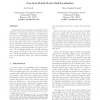Free Online Productivity Tools
i2Speak
i2Symbol
i2OCR
iTex2Img
iWeb2Print
iWeb2Shot
i2Type
iPdf2Split
iPdf2Merge
i2Bopomofo
i2Arabic
i2Style
i2Image
i2PDF
iLatex2Rtf
Sci2ools
ICRA
2000
IEEE
2000
IEEE
Practical Mobile Robot Self-Localization
A mapmaking robot integrates accumulated sensor data into a data structure that can be used for future localization or planning operations. Localization is the process of determining the robot’s location within its environment. This paper describes experiments in which a robot simultaneously makes a map and localizes to that map. The map is a collection of tangent vectors constructed from stored sonar readings localized to a series of estimated poses. The vectors retain sensed surface normal information to improve accuracy. The localization scheme is a Hough transform into a space described by the robot’s current sonar scan. The Hough transform finds a best fit in the presence of both sporadic sensor noise and discretization error.
| Added | 31 Jul 2010 |
| Updated | 31 Jul 2010 |
| Type | Conference |
| Year | 2000 |
| Where | ICRA |
| Authors | Jon Howell, Bruce Randall Donald |
Comments (0)

